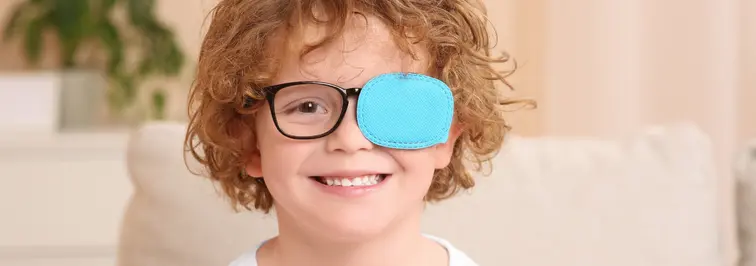Lazy eye, also known as amblyopia, is a vision disorder that typically develops during childhood. It occurs when the brain fails to process clear images from one eye, favoring the other eye instead. Over time, the weaker eye's vision deteriorates, and its development remains incomplete.
Amblyopia is not the same as strabismus (crossed eyes). While strabismus can cause amblyopia, not all cases of strabismus lead to lazy eye. If left untreated, amblyopia can become permanent after the ages of 7-10, potentially leading to vision loss. Therefore, early diagnosis and treatment are crucial. Lazy eye is a common vision problem, affecting 2-5% of children.
Causes of Lazy Eye
There are three primary causes of amblyopia:
- Strabismic Amblyopia (Caused by Eye Misalignment)
- When the eyes are misaligned, the brain suppresses the image from the weaker eye to prevent double vision.
- This suppression leads to lazy eye development.
- Refractive Amblyopia (Caused by Unequal Refractive Errors)
- If one eye has significantly higher nearsightedness (myopia), farsightedness (hyperopia), or astigmatism than the other, the brain relies on the stronger eye.
- Without correction, the brain ignores the weaker eye, resulting in amblyopia.
- Deprivation Amblyopia (Caused by Obstructed Vision)
- Conditions such as congenital cataracts, ptosis (droopy eyelid), or eye infections can send a blurred image to the brain.
- This interference prevents normal visual development, leading to lazy eye.
Risk Factors for Lazy Eye
Certain children have a higher risk of developing amblyopia:
- Family history of lazy eye
- Premature birth or low birth weight
- Developmental disorders (e.g., Down syndrome, Williams syndrome, Noonan syndrome)
- Congenital facial or cranial anomalies
Symptoms of Lazy Eye
Amblyopia can go unnoticed since the brain compensates by using the stronger eye. However, parents should look for the following signs:
- Eye misalignment (strabismus) – One eye looking in a different direction
- Frequent eye rubbing, even without fatigue
- Tilting the head or closing one eye to see clearly
- Holding objects very close when examining them
- Poor depth perception – Difficulty perceiving three-dimensional objects
If your child shows any of these symptoms, schedule an eye exam immediately.
How is Lazy Eye Diagnosed?
Lazy eye can be detected through early childhood vision screenings.
Diagnostic Tests for Infants and Young Children
- Photo-screening: Special cameras detect refractive errors and eye misalignment.
- Cover Test: One eye is covered to observe movement and dominance of the other eye.
- Snellen Vision Chart Test: For older children, vision is tested using letters or symbols.
Treatment Options for Lazy Eye
Eye Patch Therapy (Occlusion Therapy)
- The stronger eye is covered with an eye patch, forcing the weaker eye to work harder.
- Worn for several hours daily, based on the doctor's recommendation.
- Initially, children may resist wearing the patch, but consistent use improves effectiveness.
Atropine Eye Drops
- Atropine drops blur vision in the stronger eye, encouraging the weaker eye to function.
- Alternative treatment for children who struggle with wearing an eye patch.
- Possible side effects: Light sensitivity and mild eye irritation.
Prescription Glasses
- Glasses correct refractive errors, helping to treat amblyopia.
- Special filter lenses or occlusion glasses may encourage the weaker eye to develop.
Surgery (For Underlying Conditions)
- Surgery is not a direct treatment for amblyopia but may be required for conditions like:
- Strabismus correction to realign the eyes.
- Cataract removal to clear the visual pathway.
- Ptosis correction if a droopy eyelid blocks vision.
Can Lazy Eye Be Prevented?
Yes! Early detection and intervention can prevent amblyopia from becoming permanent.
How to Protect Your Child’s Vision:
- Schedule a pediatric eye exam by age 3.
- If you notice eye misalignment, squinting, or difficulty focusing, consult an eye specialist immediately.
- Ensure your child wears prescribed glasses and follows patch therapy instructions.
- Limit screen time and encourage outdoor play to promote healthy visual development.
Remember: If amblyopia is not treated early, it becomes permanent after age 7-10, making treatment difficult.
Preserve Your Child’s Vision with Early Diagnosis!
Lazy eye is treatable if diagnosed early. Prevent vision loss and support your child’s healthy eye development with regular eye check-ups. If you suspect amblyopia, consult an eye specialist today!









